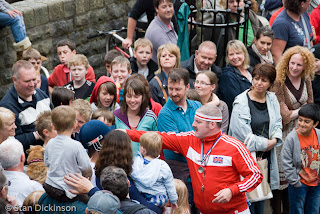I spent a large part of yesterday taking photographs at the Holmfirth Festival of Folk, an annual event that takes place over an early-May weekend around the streets and venues of Holmfirth. It’s a big event with a lot going on, so I made the decision to concentrate on what was happening outside rather than going into the pubs etc where performances were taking place inside. As the brief on ‘Structured situations’ says, this is about ‘explaining’ as well as finding telling moments.
Setting the scene right from the start, the ‘outside’ element of the festival involves people dressing up in colourful fashion and dancing/performing in public spaces – and having/giving fun, of course.
The performers come in all shapes & sizes, and from a photographic point of view, one can capture general scenes, such as the one above, or this one.
Or, there are opportunities to go in close and capture the performers faces in various states of concentration or performance, as these.
In the ‘explaining’ context, both of the above are self-explanatory, but I also took this one of a young man seemingly concentrating hard on what he is doing, but there are few, if any, clues as to what it might be.
He was performing along with a number of colleagues, and I did take a picture of the group, but they were all dressed black, performing in a line, with relatively little body movement involved, so it wasn’t especially interesting. However, if his head and shoulders shot is combined with a detail image, such as the one below, it all becomes clear, and in a visually interesting way.
There are outdoor musical performances, as well as dance.
Though sometimes, these performances produce impromptu engagement by members of the audience.And, picking up on the audience theme, that is a crucial part of the explanation of an event such as this. The audience is present in a number of the above images, of course, but there is opportunity to turn the camera on them specifically, demonstrating the varied nature of the watchers, and also their reactions to events.
The audience pictures could be ‘portraits’ or groups such as those above, or they could be more general ‘crowd’ scenes ‘scene-setters’ so to speak. This one includes part of the town and the streets, so providing a contextual aspect. Pity that the church was covered in plastic this year, but nothing I could do about that.
Of course, there are opportunities to include ‘mini-narratives’ within the overall context. One might follow the image above with the following ‘story’.
Actually, I realised afterwards that I hadn’t captured the end of the story! Which is, of course, that he caught it!
The event ends with a parade of the performers. I had not intended to stay for that, and capturing it properly means picking the right spot(s) along the route where you can get a clear enough view to get the right images. However, I did watch the start, and these, although not well-planned in terms of positioning, add some further colour and flavour to the overall series.
Great fun – and it is a splendid event to photograph. I have put a lot of pictures into this series because it was necessary to give a full explanation. The project brief doesn’t specify a number and so I have not been as selective as I might (though I did take over 100 images in the day). Picking, say, eight or ten would be quite a challenge, and I’m not going to spend time doing it, since I don’t need to!!
One other thing – I probably didn’t satisfy my tutor that, in Assignment Five, I had done enough ‘explaining’. This project has, I hope, given an opportunity to explore that side more thoroughly.





















So the weekend was one for Morris dancers and the like. I had rain where mine were. Because of this (well, the poor light really and other reasons) I'll probably end up in black and white, which is a shame because, as you've shown well, these are colourful occasions in village/small town life.
ReplyDeleteThese are difficult occasions to record in an interesting way, and you have some good shots.